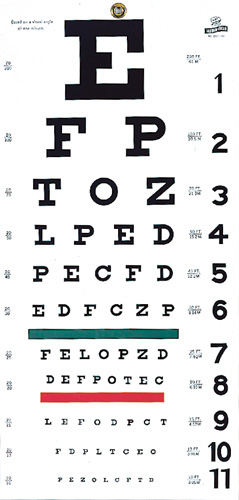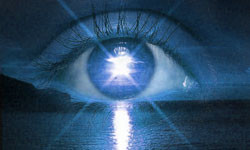People with normal vision have moments when their vision fails. At that point if they are able to adjust how they look at things they will quickly get back on track.
People with blurry vision who pursue vision improvement often notice moments of clear vision lasting several seconds or longer, so this isn’t a matter of building up your ability steadily but more so a process of becoming accustomed to looking at things in a different manner ALL THE TIME until it becomes second nature. You will not change the way you look at things all the time until you are convinced of it. So I’m working on getting things together to comprehensively and completely shred, piece by piece, every wrong idea about vision that people have, in a logical way that leaves it obvious what the only solution can be. I’m not totally clear on everything myself, but I’m working it out and have some pretty good ideas.
If you’re nearsighted, look at your hand up close at a distance you can see it best, to illustrate something. Your gaze naturally moves around the details of your hand. There isn’t any difference between the way you should look at something up close and far away except that in this case (if you’re nearsighted) you can see your hand clearly up close and nothing clearly farther away and the blur disrupts your ability to use your vision as correctly because you do not have the assistance of clear details that are essential to the process. So in a sense it’s true that if you don’t wear your glasses your vision may very well get worse, and you may feel the negative effects of abusing your eyes after some time looking at blurry things. The thing that most eye doctors don’t know, however, is that you have control over the situation. It is possible to address the situation by looking at blurry objects in a way that promotes clearer vision, and the clearer vision itself makes it easier to get even better vision, and you continue all the way to re-establishing perfect vision.
Some Eye Chart Work
 Pick a letter on the eye chart shown here that is blurry, one that you can barely read or can’t quite read. Let’s say it’s the P on line 4. For the moment you will be working with the P, the E next to it, and the O and C above it. Three letters.
Pick a letter on the eye chart shown here that is blurry, one that you can barely read or can’t quite read. Let’s say it’s the P on line 4. For the moment you will be working with the P, the E next to it, and the O and C above it. Three letters.
Look at the P, then O, then E, and back to P. So you’re moving around a triangle. Now only glance at each letter before moving to the next. Spend less than a second on each letter. You are capable of moving your eyes very quickly. See how quickly you can move around them, without tensing your eyes (more). There’s no need to slow down your process of perception. You will be tempted to stop on each letter for longer than a second in order to try to see it better. Don’t.
Now as you move between the letters, you’re going to add an extra step on E. When you look at the E, pick any spot on the E, and then see if you can distinguish a second spot on it. So for example, say you pick the bottom of the letter, and then move your attention to the top of the letter. Two opposite sides of a letter work well. It’s just like how you were moving your attention between the three letters, only on a smaller scale. If the E is too blurry for you, you will have trouble finding a second spot on the E because the blur will all overlap and maybe with double images and you won’t be sure where you’re looking. But the E also doesn’t need to be clear. This is not about seeing either of the two spots on the E clearly. This is about acknowledging the movement of your attention between opposite sides of the letter. If you can merely distinguish that the E has a top and a bottom, you can move your attention between them. Don’t expect the image itself to change as you do so. This is about learning to pay attention to a different point in turn despite the fact that the two points are close enough together that you can see them both at the same time.
So continue around the circle, only glancing quickly at each letter as before, and each time you reach the E, take that extra step of looking at a second spot on the E. It doesn’t have to be the same spots every time. Just any spots you can acknowledge as separate from each other.
After a moment of doing this, try doing it with one of the other letters too. Unless you are able to look at a second point on the letter in less than a second, move on to the next letter. Don’t struggle with finding a point. Just move on.
Remember to blink at a normal pace, every several seconds or so.
If things become clearer, don’t stop. Your mind will search for a reason to take a break right at the point where a change is starting to happen. Try moving down the chart a little, shifting your attention between letters in another triangle.
If suddenly the four letters you’re working with become so blurry that you have trouble even finding the E in the first step, what do you do? Apply the same principle. If you can’t look at something close by, look at something farther away, like the F on line 2. Then look back toward any smudge in the area where the E should be. Then try looking at one of the four letters again, and if you can’t, look back up at the F. So you always are able to revert to a backup plan of looking at something farther away.
The same if you start perceiving multiple images. Multiple images instead of fuzzy blur is a good thing. Optically I suspect there’s no difference and it’s about how your brain is perceiving things. So when your brain is perceiving multiple images it means it’s orienting itself towards perceiving details. It’s just another step, and one that you might repeat many times.
If your vision becomes darker, it may just be your pupils narrowing. I’m not sure what this means, but I tend to see it as a good sign, a change away from the wide-pupiled “fight or flight” mode.
If your eyes start stinging a little, just keep doing what you’re doing and blinking at a normal pace.
So here’s what you’re learning. When you glance at a point and you don’t see it clearly, it will be beneficial to look at another point. If you can look at another point very close by, then it will be beneficial to do so. If you are not able to distinguish a nearby point because of the confusion of it being too close to the first point, then it will be beneficial to instead look at a point farther away, and then back to the first point again. That’s the gist of it. You have a solution, no matter what happens.
A Small List of Don’ts
Don’t try to glide your eyes smoothly over an area. Your eyes are meant to move in quick jumps, small and large. To glide your eyes smoothly requires that you tense your eye muscles and suppress the speed of movements that is necessary for your eyes to work in harmony with your attention.
Don’t try to feel each movement of your eyes, or try to count the movements, or make a sound in your mind for each movement. Seeing has to be done from a mental starting point of wanting to effortlessly see and perceive. Counting eye movements or being too slow with the movements defeats the purpose, because doing so means you are not involved in perception enough. Treat this as moving your eyes as softly as you can, without being able to feel the movements.
Don’t settle into a routine of bouncing your eyes around at random spots just for the sake of moving your eyes around. This is not about moving your eyes. This is about moving your visual attention, which does require that you move your eyes, but it doesn’t do any good if you don’t pay attention to each spot you look at.
Don’t stop on a blurry point. Move on after less than a second.
Don’t lock your gaze and try to see something. Your process of seeing has to be about moving between points. If you want to see something, you have to keep looking at points as described, on and around the object.
Don’t slow down. Larger movements should be less than a second. When you are able to make smaller movements, over a smaller area, the movements will be quicker.
Bates’s Method
Two quotes by Bates directly back up the instructions above:
“It is impossible for the eye to fix a point longer than a fraction of a second. If it tries to do so, it begins to strain and the vision is lowered. This can readily be demonstrated by trying to hold one part of a letter for an appreciable length of time. No matter how good the sight, it will begin to blur, or even disappear, very quickly, and sometimes the effort to hold it will produce pain.”- Perfect Sight Without Glasses, Ch 20
“The shorter the shift the greater the benefit; but even a very long shift – as much as three feet or more – is a help to those who cannot accomplish a shorter one. When the patient is capable of a short shift, on the contrary, the long shift lowers the vision.” – Perfect Sight Without Glasses, Ch 15
Dr. Bates described something along the lines of what I described here, and variations of it, but he included only two points. With two points it’s too easy for you to eventually start oscillating your eyes back and forth without really paying attention to what you’re looking at with each movement. With three points or more, you have to put a little more attention into it to locate each letter, and the act of moving your eyes in three different directions or more helps avoid getting stuck in a mentally vacant routine of oscillating your eyes.
get help on our Facebook Group!

I founded iblindness.org in 2002 as I began reading books on the Bates Method and became interested in vision improvement. I believe that everyone who is motivated can identify the roots of their vision problems and apply behavioral changes to solve them.
